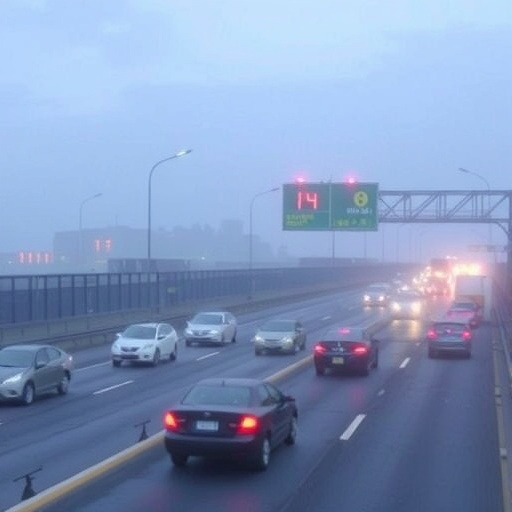
Traffic-related air pollution (TRAP) remains one of the most pressing environmental health challenges facing urban populations worldwide. As cities grow denser and traffic volumes surge, the silent infiltration of harmful pollutants into the air we breathe translates to a mounting public health crisis. Understanding the dynamics of exposure is crucial to designing effective interventions. This is where the concept of intake fraction (iF) steps into the spotlight, providing an indispensable quantitative measure that bridges the gap between pollutant emissions and human exposure.
At its core, intake fraction defines the ratio between the total amount of pollution inhaled by a defined population and the emissions released by a specific source over a given timeframe. This ratio encapsulates complex interactions among pollutant dispersion, population distribution, breathing rates, and exposure duration, offering a singular metric that synthesizes multiple variables into actionable insights. With the advancement of modeling techniques and data resolution, intake fraction methodologies have evolved, enabling finer assessments that can inform urban planning, emission control strategies, and public health risk assessments.
A groundbreaking comprehensive review recently published by Meng, Qi, Wu, and colleagues in the Journal of Exposure Science and Environmental Epidemiology dives deep into the myriad methods applied to calculate intake fraction in the context of traffic-related air pollution exposure. This review not only catalogs current methodologies but also examines their underlying assumptions, variations in application, and potential trajectories for future research. The study, appearing in 2025, represents a pivotal step in consolidating dispersed knowledge on a metric that holds the key to unraveling the health risks posed by urban traffic emissions.
.adsslot_CSekEiz05X{width:728px !important;height:90px !important;}
@media(max-width:1199px){ .adsslot_CSekEiz05X{width:468px !important;height:60px !important;}
}
@media(max-width:767px){ .adsslot_CSekEiz05X{width:320px !important;height:50px !important;}
}
ADVERTISEMENT
Traffic-related air pollution is characterized by a complex mixture of pollutants, including nitrogen oxides (NOx), particulate matter (PM), volatile organic compounds (VOCs), and carbon monoxide (CO), among others. These compounds originate predominantly from the combustion engines of vehicles, especially those reliant on fossil fuels. The intricate chemical interactions and transformations these pollutants undergo once emitted further complicate exposure assessments. Intake fraction methods must therefore accommodate not only the initial emission magnitudes but also the spatial-temporal evolution of these pollutants within urban atmospheres.
One of the challenges highlighted in the review pertains to the variability of intake fraction across different spatial scales. At a micro-scale, intake fractions can vary dramatically over mere meters due to local traffic density, street canyon effects, and meteorological conditions such as wind speed and direction. This spatial heterogeneity demands high-resolution models that can capture the nuanced dispersion and dilution of pollutants. Conversely, city-wide or regional assessments require different modeling approaches, often relying on averaged data and assumptions that may mask local hotspots of exposure.
Another important dimension analyzed in the review is the temporal variability inherent in traffic-related air pollution exposure. Traffic patterns fluctuate hourly, daily, and seasonally, influenced by human behavior, regulatory measures, and climatic factors. Intake fraction calculations must therefore integrate dynamic emission profiles to reflect realistic exposure scenarios accurately. Models incorporating real-time traffic data and sensor networks have emerged as promising tools, albeit challenges persist in data availability and computational demands.
Central to intake fraction modeling is the demographic and physiological characteristics of the exposed population. Breathing rates differ significantly by age, activity level, and health status, influencing the actual dose of pollutants inhaled. Moreover, the spatial distribution of sensitive subpopulations—such as children, elderly individuals, or those with preexisting respiratory conditions—plays a critical role in assessing health impacts. The reviewed studies emphasize the need for integrating demographic data to tailor intake fraction estimates toward vulnerable groups, thereby enhancing the relevance for public health interventions.
The authors also delve into methodological variations, contrasting direct measurement approaches with computational modeling techniques. Direct measurements, while valuable, are often resource-intensive and limited in spatial and temporal coverage. In contrast, modeling approaches—ranging from Gaussian plume dispersion models to advanced computational fluid dynamics (CFD) simulations—offer broader applicability but hinge on the accuracy of input data and underlying assumptions. Hybrid methods combining measurements and modeling have been gaining traction as a way to validate and refine intake fraction estimates.
Another insight from the review pertains to the incorporation of multi-source emission scenarios in intake fraction analysis. Urban traffic rarely acts in isolation; emissions from industrial activities, residential heating, and even natural sources interact within the atmospheric milieu. The complexity of these overlapping contributions necessitates sophisticated source apportionment techniques within intake fraction frameworks to disentangle the relative impacts of traffic-related pollutants. This separation is critical for policymakers seeking targeted mitigation strategies.
Technological advancements in air pollution sensing and data analytics have opened new frontiers for intake fraction research. Low-cost sensor networks deployed across urban landscapes capture granular air quality data, feeding into high-resolution exposure models. Furthermore, machine learning algorithms are increasingly employed to detect patterns and predict intake fraction values under varying conditions, providing adaptive tools for real-time exposure management. The review underscores the importance of integrating these technologies for next-generation intake fraction methodologies.
Looking ahead, the review by Meng et al. signals several future directions in this domain. One promising avenue is the harmonization of intake fraction calculation protocols to enable comparability across studies and geographies. Standardization efforts would facilitate meta-analyses and the development of universal benchmarks for exposure assessment. Additionally, extending intake fraction concepts to incorporate emerging pollutant classes, such as ultrafine particles and secondary organic aerosols, could broaden the scope of health impact evaluations.
The societal implications of refining intake fraction methods are profound. Enhanced exposure assessments underpin evidence-based policymaking aimed at reducing traffic emissions and protecting public health. By quantifying who breathes what and how much, urban planners can optimize traffic flows, implement low-emission zones, and design green infrastructure that mitigates exposure. Public health agencies can also allocate resources more efficiently by identifying high-risk neighborhoods and prioritizing interventions.
Importantly, the review highlights the role of intake fraction in environmental justice considerations. Traffic-related air pollution disproportionately affects marginalized communities situated near major roadways or industrial corridors, exacerbating health inequities. Accurate intake fraction assessments can bring these disparities to light, supporting advocacy and policy actions to address systemic environmental burdens.
In sum, intake fraction stands as a crucial metric in the quest to decode the intricate linkage between traffic emissions and human health. The comprehensive synthesis of methods and insights presented by Meng and colleagues offers the research community a solid foundation and a clear path forward. As cities worldwide grapple with escalating traffic and environmental challenges, the precision and adaptability of intake fraction methodologies will be vital tools in crafting healthier, more equitable urban futures.
The unfolding narrative of intake fraction research exemplifies the convergence of environmental science, epidemiology, and technology. With continued innovation and interdisciplinary collaboration, these methodologies promise not only to illuminate the shadowy contours of pollution exposure but also to translate scientific understanding into tangible improvements in urban air quality and population well-being.
Subject of Research: Traffic-related air pollution exposure assessment through intake fraction methodologies.
Article Title: Comprehensive review of intake fraction methods for assessing traffic-related air pollution exposure: insights, variations, and future directions.
Article References:
Meng, S., Qi, L., Wu, P. et al. Comprehensive review of intake fraction methods for assessing traffic-related air pollution exposure: insights, variations, and future directions. J Expo Sci Environ Epidemiol (2025). https://doi.org/10.1038/s41370-025-00775-1
Image Credits: AI Generated
DOI: https://doi.org/10.1038/s41370-025-00775-1
Tags: comprehensive review of air pollution metricsemission exposure ratioenvironmental health challengesintake fraction methodspollutant dispersion modelingpopulation exposure dynamicspublic health impact of air pollutionquantitative measures of air qualitytraffic emissions and health riskstraffic-related air pollutionurban air quality assessmenturban planning and pollution control



